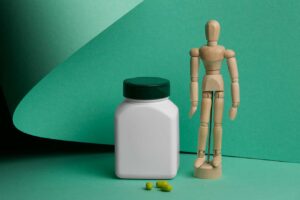What are the Physical Signs of Opioid Addiction?
Recognizing the physical signs of opioid addiction can be the difference between early intervention and a life-threatening dependency. Your body provides clear warning signals when prescription pain medication crosses the line from therapeutic use to addiction.
Common Physical Signs of Opioid Addiction
Here are some common physical signs that may indicate opioid addiction:
- Small pupils: One of the most recognizable early indicators is constricted pupils. When under the influence of opioids, your pupils become very small, even in low light conditions.
- Persistent drowsiness: If you find yourself excessively sleepy during normal waking hours, it could be a sign that your body has developed a tolerance to opioids and requires higher doses to function.
- Changes in eating patterns: As addiction progresses, you may experience significant appetite suppression, unexplained weight loss, disinterest in foods you once enjoyed, and irregular meal patterns.
- Opioid withdrawal symptoms: When your body craves the next dose, you may experience flu-like symptoms such as nausea, vomiting, excessive sweating, chills, and uncontrollable shaking. These symptoms indicate that your body is dependent on opioids.
- Declining personal hygiene habits: Neglecting basic self-care routines like showering, brushing teeth, or changing clothes regularly can be a subtle but critical warning sign of opioid addiction.
- Decreased sexual interest: A decrease in sexual desire or interest may also accompany opioid addiction.
These physical manifestations demand immediate attention and professional intervention. If you or someone you know is exhibiting these signs, it is important to seek help from a qualified healthcare professional or addiction specialist.
2. What are the Behavioral Signs That You May Be Addicted to Opiates?
Behavioral signs of opioid addiction show through patterns that deviate from your prescribed medication routine. When you find yourself taking opioids in larger amounts or for longer periods than prescribed, this signals a loss of control over your usage. This misuse of prescription opioids represents one of the clearest behavioral indicators that addiction has begun to take hold.
1. Loss of Control Over Usage
When you find yourself taking opioids in larger amounts or for longer periods than prescribed, this signals a loss of control over your usage.
2. Intense Cravings and Obsession
Opioid cravings become a dominant force in your daily thoughts and actions. You may notice an obsessive focus on obtaining more medication, constantly calculating when your next dose is due, or feeling anxious when your supply runs low. These intense urges often drive you to seek multiple prescriptions from different doctors or purchase pills from unauthorized sources.
3. Dangerous Methods of Consumption
The methods of consumption change dramatically as addiction progresses. Using opioids in unintended ways such as snorting or injecting crushed pills indicates a dangerous escalation in your relationship with these substances. This behavior significantly increases your risk of overdose and other serious health complications.
4. Unpredictable Mood Swings
Emotional instability becomes increasingly apparent through unpredictable mood swings. You might experience:
- Sudden irritability when questioned about medication use
- Unexplained nervousness or anxiety
- Episodes of inappropriate giddiness
- Periods of deep depression
5. Social Isolation and Secrecy

Social withdrawal marks another critical behavioral change. You begin isolating yourself from family and friends, becoming secretive about your activities and whereabouts. Your social circles shift toward individuals who can provide access to opioids, while previous friendships and hobbies lose their importance.
6. Decline in Work and Academic Performance
Work and academic performance decline as addiction-related distractions consume your mental energy.
If you’re asking yourself “am I addicted to opiates?” these behavioral patterns provide crucial insight into your relationship with these medications.
3. What are the Psychological Indicators Of Opioid Addiction?
The mind reveals addiction patterns through distinct psychological signs of opioid addiction that often emerge before physical symptoms become apparent. Your mental state undergoes significant changes as dependence develops, creating warning signals you shouldn’t ignore.
1. Anxiety about Medication Shortage
Anxiety about medication shortage becomes a consuming fear when you find yourself constantly calculating remaining pills, checking prescription dates, or panicking about running out early. This preoccupation with supply indicates your brain has shifted from therapeutic use to dependency-driven thinking. You might catch yourself hoarding pills, taking inventory multiple times daily, or feeling genuine terror at the thought of being without your medication.
2. Denial of Addiction Severity
Denial of addiction severity manifests as persistent minimization of your usage patterns and their consequences. You rationalize increasing doses as necessary for pain management, dismiss concerns from loved ones as overreactions, or convince yourself that prescription medications can’t be truly addictive. This psychological defense mechanism protects the addiction by preventing you from acknowledging the reality of your situation.
3. Emotional Regulation Dependence on Opioids
Your emotional regulation becomes increasingly dependent on opioid availability, creating a cycle where psychological distress drives continued use rather than legitimate medical need. Such patterns often lead to opioid addiction, further complicating your mental health and overall well-being.
4. What are the Advanced Warning Signs Of Severe Opioid Addiction?
When opioid addiction progresses to advanced stages, the warning signs become more alarming and harder to ignore. These indicators represent a critical escalation that demands immediate attention and professional intervention.
1. Discovery of drug paraphernalia
The presence of drug paraphernalia in your living spaces signals a dangerous progression beyond prescription misuse. You might come across:
- Spoons with burn marks or residue
- Syringes or needles hidden in drawers, closets, or personal belongings
- Small bags containing powder residue
- Aluminum foil with dark streaks
- Rubber tubing or makeshift tourniquets
Such findings often indicate a shift towards illegal drug use, which can have severe legal and health implications.
2. Missing medications
Missing medications from your own prescription bottles or those belonging to family members becomes a pattern you can no longer explain away. You may find yourself counting pills obsessively or discovering that bottles empty faster than expected.
3. Track marks concealment
Consistently wearing long sleeves, even in warm weather, indicates injection drug use. You might notice yourself making excuses to cover your arms or avoiding situations where short sleeves would be appropriate.
4. Behavioral changes
If you’re noticing significant behavioral changes in a loved one, especially if they are a teenager, it could be a sign of drug use. This may include sudden changes in mood, withdrawal from family and friends, and a decline in academic performance.
These advanced opioid addiction signs represent a medical emergency requiring immediate professional help to prevent potentially fatal consequences.
5. What are the Withdrawal Symptoms When Stopping Opioids?
Physical dependence opioids creates a cycle where your body requires the substance to function normally. When you attempt to stop using opioids abruptly, opioid withdrawal symptoms manifest as your system struggles to readjust without the drug.
The withdrawal experience resembles a severe flu, bringing:
- Intense nausea and vomiting
- Muscle aches and joint pain
- Profuse sweating and chills
- Diarrhea and stomach cramping
- Restlessness and insomnia
- Anxiety and irritability
These symptoms typically begin within 6-12 hours after your last dose and can persist for several days to weeks. The severity depends on factors like dosage, duration of use, and individual physiology. Professional medical supervision becomes essential during this phase, as attempting to detox alone can be dangerous and often leads to relapse when symptoms become unbearable.
Seeking Help For Your Struggle With Opioid Addiction: Where To Turn?
Recognizing you need help represents the first crucial step toward recovery. Where to get help for opiate addiction depends on your specific circumstances, severity of addiction, and personal support system.
Treatment Program Options
If you’re looking for opioid rehab in Los Angeles, there are various treatment program options available. Outpatient programs allow you to maintain work, school, or family responsibilities while receiving treatment. These programs typically include:
- Regular counseling sessions
- Group therapy meetings
- Medical monitoring
- Flexible scheduling around your daily commitments
Residential treatment programs provide 24/7 medical supervision and intensive therapeutic support. You’ll benefit from:
- Structured daily routines
- Immediate medical intervention
- Peer support from others in recovery
- Removal from triggers and temptations
Medication-Assisted Treatment (MAT)
Medical professionals often combine medications with counseling for comprehensive care:
- Methadone: Reduces cravings and withdrawal symptoms while blocking euphoric effects
- Buprenorphine: Partially activates opioid receptors, minimizing withdrawal discomfort
- Naltrexone: Blocks opioid receptors entirely, preventing any euphoric response
These medications work most effectively when paired with behavioral therapy, counseling sessions, and ongoing support groups. Your treatment team will determine which combination best addresses your individual needs and medical history.
The path to recovery requires professional guidance tailored to your unique situation and addiction severity. If you’re ready to take that step, don’t hesitate to contact West Valley Detox & Treatment today for assistance.
How To Stop Taking Prescription Pills Safely With Professional Guidance?

Stopping opioids safely requires medical supervision to prevent dangerous complications. Abrupt discontinuation can trigger severe withdrawal symptoms and potentially life-threatening reactions, making professional guidance essential for your safety.
Your doctor will create a personalized tapering schedule that gradually reduces your dosage over weeks or months. This controlled approach minimizes withdrawal discomfort while allowing your body to adjust naturally. Following your doctor’s orders carefully prevents rebound effects and reduces the risk of relapse.
Medical professionals monitor your progress throughout the process, adjusting the timeline based on your individual response. They may prescribe comfort medications to manage withdrawal symptoms like nausea, anxiety, and sleep disturbances.
If you’re wondering “how do I stop taking my pills” safely, never attempt this alone. Opioid addiction recovery requires comprehensive medical support to ensure your physical and mental well-being during this critical transition period.
Recovery Month 2025: A Time To Raise Awareness And Seek Help For Those Struggling With Opioid Addiction
Recovery Month 2025 serves as a powerful reminder that healing from opioid addiction is possible. This annual observance breaks down barriers that prevent people from seeking treatment for opiate addiction. The stigma surrounding substance use disorders often keeps individuals suffering in silence, afraid to reach out for the help they desperately need.
Recovery Month creates opportunities for communities to celebrate recovery stories and highlight available resources. If you’re wondering “where can I get help for opiate addiction,” this awareness campaign connects you with treatment centers, support groups, and healthcare professionals who understand your struggle.
The significance of this observance extends beyond education—it transforms shame into hope. Recovery Month demonstrates that addiction is a medical condition, not a moral failing, encouraging more people to take that crucial first step toward healing. This first step often involves medical detox, an important process that offers a safe and medically supervised environment for individuals to overcome substance dependence.
Additionally, if you or someone you know is hesitant about entering rehab, there are sensitive ways to approach this conversation. Understanding how to gently suggest rehab to a friend can make a significant difference in their journey toward recovery.
FAQs (Frequently Asked Questions)
What are the common physical signs of opioid addiction?
Common physical signs of opioid addiction include small pupils, drowsiness, changes in appetite leading to weight loss, flu-like symptoms such as nausea, vomiting, sweating, chills, and shaking. Additionally, decreased respiratory rate and poor hygiene along with decreased libido can be subtle but important warning signs of developing addiction.
How can behavioral changes indicate opioid addiction?
Behavioral signs that may indicate opioid addiction include taking opioids in larger amounts or for longer periods than prescribed, intense cravings and obsessive focus on obtaining opioids, misuse of prescription opioids through snorting or injecting crushed pills, mood swings like irritability or depression, social isolation, secrecy about drug use activities, shifting social circles towards drug use, and declining work or academic performance.
What psychological indicators suggest someone might be addicted to opioids?
Psychological indicators of opioid addiction include anxiety about running out of prescribed medication and denial about the severity of opioid use or its harmful effects on health and personal relationships. These mental health challenges often accompany ongoing opioid dependence.
What are the advanced warning signs of severe opioid addiction?
Advanced warning signs of severe opioid addiction include finding missing medications or discovering drug paraphernalia such as spoons, syringes, or powder residue bags. Consistently wearing long sleeves to conceal track marks from injections is also a serious indicator of advanced stage addiction requiring immediate attention.
What withdrawal symptoms occur when stopping opioids?
Withdrawal symptoms when stopping opioids can resemble illness-like conditions including nausea, vomiting, sweating, chills, shaking, and flu-like discomfort. These symptoms highlight physical dependence on opioids and underscore the importance of seeking professional help during detoxification phases.
Where can individuals struggling with opioid addiction find help?
Individuals struggling with opioid addiction can seek help through outpatient or residential treatment programs tailored to their needs. Effective treatment options include medications like methadone, buprenorphine, and naltrexone combined with counseling support. Following doctors’ orders carefully when discontinuing opioids ensures safety during recovery. Recovery Month 2025 also promotes awareness and reduces stigma surrounding substance use disorders.



